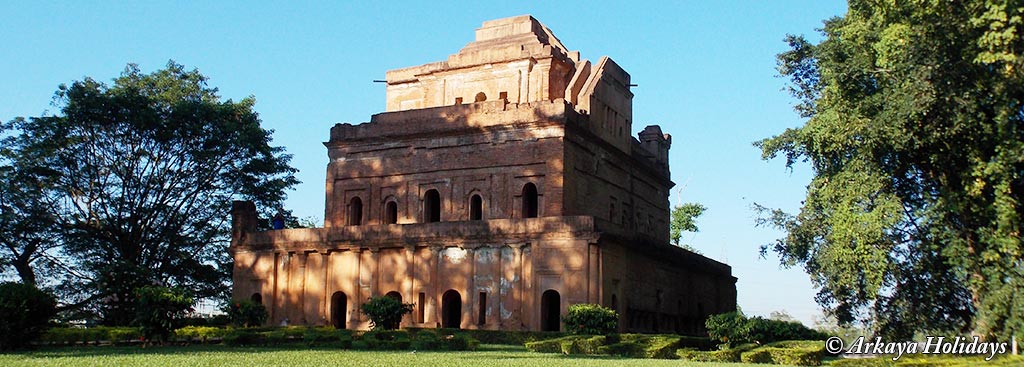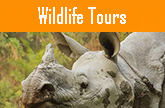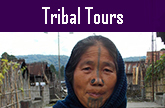Assam Tourist Places
Kaziranga National Park
Internationally popular forest reserve and a UNESCO World Natural Heritage site, Kaziranga National Park is situated on the northern banks of the mighty river Brahmaputra, spreading wide on both the Golaghat and Nagaon districts of Assam. It covers an area of over 430 sq km. Its landscape is characterized by swamps, beels, tall elephant grass, flat grasslands with streams.
Kaziranga National Park supports a variety of flora and fauna. It is mainly the undistributed residence of the Great One horned Rhinoceros. It is also a home to a large population of Indian Elephant, Wild Water Buffalo, Swamp Deer, Indian Boson, Royal Bengal Tiger, Sloth Bear, Hog Deer, Leopard Cats, Otter, Hog Badger, Capped Langur, Hollock Gibbons, Wild Boar, Jackal, Pythons, Monitor Lizard and Fishing Cat etc. Small mammals like the rare Hispid Hare, Indian Gray Mongoose, Large Indian Civet, Small Indian Civet, Bengal Fox, Golden Jackal, Chinese Pangolin, Indian Pangolin, Hog Badger, Chinese Ferret Badger, Parti-colored Flying Squirrels etc. are also found here.
More than 500 species of birds have been recorded in Kaziranga National Park including 25 species of globally threatened category. Migratory birds like Lesser White Fronted Goose, Ferruginous Duck, Baer's Pochard Duck and Lesser Adjutant, Greater Adjutant, Black Necked Stork, Asian Openbill Stork etc. migrate to this park during the winter season every year. It is also a habitat of threatened species like Blyth's Kingfisher, White Bellied Heron, Dalmatian Pelican, Spot-billed Pelican, Nordmann's Greenshank, Black-Bellied Tern and other birds like the Eastern Imperial Eagle, Palla's Fish Eagle, Grey Headed Fish Eagle, Lesser Kestrel, Indian Vulture, Slender billed Vulture, Indian White-rumped Vulture, Swamp Francolin, Bengal Florican, Pale-Capped Pigeon, Black Breasted Parrotbill and Rufous vented Prinia etc.
It is also a homeland to the endangered Gangetic Dolphin. Besides there are more than 40 species of fishes and 42 species of reptiles are found in Kaziranga National Park. Rich in floral diversity, vegetation of Kaziranga National Park comprises of alluvial inundated grasslands, alluvial savannah woodlands, tropical moist mixed deciduous forests and tropical semi evergreen forests. The annual rainfall ranges 2220 mm. While winters are mild and dry, summers are hot and rainy with the monsoons at its peak stage during the months of July and August.
Recent Rhino population in Kaziranga National Park numbers to 2329. (March, 2013 census)
Guwahati
Guwahati, 'the city of Eastern light' stands on the southern bank of the mighty river Brahmaputra. It is the capital city of Assam and the gateway to the entire north-eastern states. Modern Guwahati is the hub city of Assam. It fulfills every aspect of a metropolitan city with its advanced means of transport, communication and media, as a major center of business activity, educational institutions, and various administrative and political activities of entire Assam. Besides, its landscape surrounded by hills and the mighty Brahmaputra River, rich and diverse flora and fauna enhances its natural scenic beauty.
Kamakhya Temple:
Kamakhya Temple, one of the greatest ‘Shaktipeeth’, the shakti shrine of Goddess Kamakhya is situated on the Nilachal Hills. It is the oldest center of Tantric Shaktism. A famous legend regarding the birth of the Kamakhya temple narrates that Lord Shiva, rage with anger at his wife Sati’s death, wandered the entire earth carrying Sati’s corpse. An organ of Sati fell here and eventually the place became a temple of worship in due course of time. The temple features various stone inscriptions, terracotta works, sculptures and idols of Ganesha and Chamundeswari which are worth mentioning. The famous ‘Ambubachi Fair’ is celebrated with great enthusiasm every year in mid-June in this temple and devotees from different parts of India throng into it for the special occasion.
Navagraha Temple:
Built by the Ahom king Rajeshwar Singha in 1752 AD, Navagraha temple stands on the crest of the Citrachala hill, situated in the south-east of Guwahati. The temple possesses nine Shiva lingas representing the nine sacred planetary Gods. The temple continues to be a center for the study of astrological and astronomical research.
Srimanta Sankardev Kalakshetra:
Sankardev Kalakshetra is named after the most illustrious son and Vaishnavite propagator of Assam. It is the hub of all the cultural activities of entire Assam and a center for the promotion and preservation of the cultural heritage of the various tribes, communities and ethnic groups of Assam. It consists of a museum wherein lies the various traditional dresses, jewelry, ancient pottery, weapons belonging to various ethnic groups, sculpture, and works of art created by various artists depicting as a whole the entire Assam. The open air amphitheatre, wherein the cultural performances are held very often and the collection of whole life activities of the legendary artist Dr. Bhupen Hazarika carry a great measure in Kalakshetra.
Umananda Temple:
It is a legendary temple of Lord Shiva built by Ahom King Gadadhar Singha in 1664 AD. The temple is standing in an island hill in the middle of great Brahmaputra River. The temple possesses rock-cut figures and sculptures of God Surya, Ganesha, Shiva and Vishnu along with his ten incarnations. The temple is a major centre for the celebration of Shivaratri. The easiest means of transport to this temple is country boat or engine boat which is an added attraction to the tourists.
Sukreshwar Temple:
Standing on the south bank of the mighty river Brahmaputra on the Dakini Jogini Hill, Sukreshwar Temple holds its prominence as a famous historical and religious site of Assam. This temple was built in 1744 AD under the reign of Ahom king Pramatta Singha. The temple is acclaimed to possess the sixth Jyotirlinga of India. Apart from religious importance, the temple owes an educational value due to the presence of a Sanskrit ‘Tol’ promoting Sanskrit education.
Vasistha Aashram:
Vasistha Aashram is the hermitage of the great sage Vasistha Muni. Situated on the Sandhyachal Hill, on the southern part of the city, it is one of the main tourist attraction spot. The confluence of the three streams called Sandhya, Lalita and Kanta flowing through the aashram adds a pleasant and scenic charm to the temple. Legend narrates that Basistha Muni brought down the celestial Ganga for his daily ablutions and still flowing in trifurcated streams.
Balaji Temple:
Popularly known as the Purva Tirupati, Sri Balaji Temple is a famous religious site carved in the south Indian style of architecture. The temple was set up in 1998 AD to fulfil the devotional wish of His Holiness Jayendra Saraswati, Sankaracharya of Kanchi Kamakoti Peetom Tamil Nadu.
Sualkuchi:
Popularly known as ‘Manchester of the East’, Sualkuchi is the major centre for commercial production of Assam textile- ‘Muga’, ‘Paat’, ‘Eri’ and ‘Endi’ cloths and is globally famous for cottage and handloom industries. Sualkuchi is regarded as the paradise of the extremely beautiful Assam silk woven in almost every household. It is often considered as “Manchester of the East”.
Hajo:
The meeting point of three religions – Hinduism, Islam and Buddhism, Hajo is a famous pilgrim hub of Assam which serves as a main centre reflecting Assamese culture and learning. This holy place is marked by a number of ancient temples and artifacts representing Assamese art & culture. The Hayagriva-Madhab temple, an ancient stone temple of Hajo, situated on the Monikut Hill is dedicated to Lord Vishnu. It is a famous pilgrimage centre for the Buddhists and Hindus where devotees celebrate Doul, Bihu and Janmastami with great pomp and joy every year. Poa Mecca is the Muslim pilgrimage centre at Hajo. It is popularly believed that devotees achieve one fourth spiritual enlightenment of what could be gained at Mecca by offering prayer to the Lord in this holy mosque.
Pobitora Wildlife Sanctuary
Pobitiora Wildlife Sanctuary is situated in the Morigaon district. It is a major wildlife sanctuary in Assam covering an area of 38.8 sq kilometers out of which 15.9 sq kilometers area is the effective Rhino habitat. Pobitora Wildlife Sanctuary is mainly famous for its Great Indian One-horned Rhinoceros. Other important animals found in the sanctuary are Asiatic Buffalo, Leopard, Wild Boar, Civet Cat etc. Besides, 157 species of birds have been witnessed in the sanctuary so far.
According to April 2012 census, Pobitora Wildlife Sanctuary is a home to 93 Rhinos.
Deepor Beel Bird Sanctuary
Deepor beel (meaning lake in local Assamese language), situated at the south-western part of Guwahati city is claimed to be the first bird sanctuary of Assam. It comprises an area of 40 sq kilometers of which 4.14 sq kilometers is declared as a bird sanctuary by the Govt. of Assam. Deepor beel is a permanent fresh water lake, located in a former channel of the mighty Brahmaputra River. The main sources of water are Basistha and Kalmini Rivers. At the time of flood in monsoon, the beel is approximately 4 meters deep while in the winter season, its level of depth decreases to just about 1 meter. The beel drains into Brahmaputra River through Khonajan channel, situated at a distance of 5 kilometes to the North.
Deepor Beel is gifted with a wide variety of flora and fauna. More than 220 species of birds have been recorded in the beel including 70 species of migratory birds. A record number of 19000 water birds have been witnessed in a single day count so far. Globally threatened birds like Greater Adjutant Stork, Lesser Adjutant Stork, Spotbilled Pelican, Baer's Pochard, Pallas' Sea Eagle etc are seen here. Common birds like Indian Pond Heron, Spot billed Duck, Common Teal, Bar-headed Goose, Little cormorant, Green Sand Piper, Common Sand Piper, Grey Headed Lapwing are found in the beel. A large number of migratory birds like Siberian Crane visit the beel in every winter season. Apart from these, Deepor beel harbours as many species as 20 amphibians, 18 snakes, 12 lizards and 6 turtle & tortoises.
Barpeta
Barpeta is renowned to be the home of various Satras (monasteries), temples, mosques, shrines, rivers and the Gateway to Manas National Park. Acclaimed for its natural beauty and religious significance, Barpeta is also widely famous for its cultural and traditional crafts like pottery, wooden crafts, masks, gold ornaments and ivory carvings. Sarthebari is the home of household bell and brass-metal industry.
Barpeta Satra:
Barpeta Satra (monastery) was established by great Vaishnavite saint Shri Shri Madhav Dev, the disciple of Shrimanta Shankar Dev. The reflection of religious and cultural tradition of Barpeta Satra is very ancient and unique. Madhav Dev stayed for 8 long years and produced his best literature here. The Satra encompasses a large area with an entrance gate known as ‘Batsora’. Prayers or ‘Naam Kirtan’ are held in the prayer hall named ‘Kirtan Ghar’. The Satra owned some other important wings which are not found in other satras of Assam. Those are Jagmohan Ghar, Daul Ghar, Paat Chang, Saaj Ghar, Bhaaj Ghar and the Math. These structures are beautiful and are used in different purposes of the satras. Devotees gather in large numbers during the anniversaries of Vaishnava Gurus and Doul festival.
Manas National Park
Manas National Park is situated on the foothills of the Himalayas in the district of Barpeta. It is a famous Tiger Reserve of Assam. It encompasses an area of 519.77 sq km and is a home to many rare and endangered species of flora and fauna. It's rich bio-diversity and wealthy wildlife enhances the scenic beauty and glory of this park. Around 550 varieties of plant species identifies the rich flora of Manas National Park. It is a homeland to 60 species of mammals, 312 species of birds (26 species are endangered ones), 42 species of reptiles and amphibians, 54 species of fishes and 103 species of invertebrates.
Manas National Park is an ideal habitat to rare species such as One Horned Rhinoceros, Asian Elephant, Royal Bengal Tiger, Pygmy Hog, Hispid hare, Golden Langur, Bengal Florican, Gaur, Assam Roofed Turtle and Rat Snake. Leopard, Clouded Leopard, Himalayan Bear, Wild Boar, Sambar, Swamp Deer, Hog Deer are the common inhabitants of this park. Hundreds of migratory birds like Riverchats (White Capped Redstars) Forktails, Cormorants, and Ruddy Shelduck visit this park during the winter season.
According to March, 2013 census, Manas National Park shelters only 23 Rhinos.
Tezpur
Tezpur, the ‘city of love’ is situated on the northern banks of the Brahmaputra River. The ancient name of Tezpur was Sonitpur, the kingdom of the mighty legendary king, Baan Raja. It was the capital city under his reign. Tezpur holds in its heart many ancient historical events, and witnessed many legends and mythological wars of ancient Assam. The occurrence of a famous war named ‘Hari-Hara’ is related with the attainment of the present day Tezpur. This battle led to the bloodshed of so many soldiers that the entire place was stained with blood and hence the city came to be known as Tezpur (‘Tez’ meaning blood and ‘pur’ meaning city in Assamese language. Present day Tezpur was founded by the British colonial administration in 1835 as the headquarters of Darrang district.
Agnigarh:
Legend speaks of Agnigarh as a fortress built by Baan Raja in order to keep his daughter in isolation. The word ‘Agnigarh’ is a derivation of two Sanskrit words: ‘Agni’ meaning ‘fire’ and ‘garh’ meaning ‘fort’. Situated on the north bank of the Brahmaputra River, it maintains its gracefulness with its lush green landscapes of the river. Nowadays, magnificent works of sculpture are depicted referring to the love story of Usha-Aniruddha and Great War ‘Hari-Hara Juddha’.
Mahavoirab Temple:
Mahavoirab temple is the oldest Shiva shrine, where the second biggest Shiva linga of the world is worshipped. The temple was built by King Baan, the ruler of Sonitpur in 10th century. King Baan’s daughter Princess Usha was a devotee of Lord Shiva and visited the temple for daily worship. Thousands of devotees gather during Shivaratri every year to offer prayers in this temple.
Da-Parbatia:
Da-Parbatia contains an ancient door frame constructed during 5th-6th century. It bears testimony to some finest and exquisite sculpture work of the Gupta period. Here, two finely craved statues of Ganga and Yamuna possessing garlands in their hands are erected facing each other which exhibit the mastery of expert sculptors of that time. Various legends and scholars are of varied views stating this spot to be a Surya temple and some regards it to be the place of ruins of an old Shiva temple.
Nameri National Park
Nameri National Park is situated in the foothills of Eastern Himalayas and covers an area of about 200 sq km, stretching along both banks of the Jia Bhoroli River in the district of Sonitpur. The park is identified with its rich diversity of flora and fauna. It consists of semi-evergreen vegetation, moist deciduous forests and open grasslands along with about 600 species of flora.
It is the famous resident place for Asian Elephants. It is also a homeland to Royal Bengal Tiger, Leopard, Clouded Leopard, Indian Bison, Gaur, Wild Boar, Sloth Bear, Himalayan Black Bear, Capped Langur, Indian Giant Squirrel, Pygmy Hog, Indian Wild Dog and Civet Cat. Various beautiful birds like White Winged Wood Duck, Great Pied Hornbill, Wreathed Hornbill, Black Stork, Ibis Bill, Blue-bearded Bee Eaters, Babblers, Plovers, Rufous Necked Hornbill etc. are also found here. The easiest means to explore the forest is on foot (accompanied by forest guard).
Orang National Park
Orang National Park is situated on the north bank of river Brahmaputra. The park comprises mainly of swampy grasslands, with numerous trees and tall grasses covering an area of 78.81 sq km. About 12 beels (wetlands) exist in the park which serves as a home to thousands of migratory birds in the winter season. The park is famous for its main attractions like Great Indian One-horned Rhinoceros, Asian Elephant, Sambar Deer, Barking Deer, Pangolin, Hog Deer, Civet Cat, Otters, Wild Boar etc. Birds including Pelican, Cormorant, Greylag, Gose, Large Whistling Teal, Greater Adjutant Stork, Kingfisher, and King Vulture are also found here in large numbers.
Rhino population in Orang National Park numbers to 100. (April, 2012 census)
Majuli Island
Majuli, the largest river island in the world, is being short listed for future status of UNESCO World Heritage Site. The formation of this river island dates back to 1691 AD, when a great flood swept Assam and created a new island in the midst of river Brahmaputra. Majuli is acclaimed mainly as the main centre of Vaishnavite culture and satras of Assam. Srimanta Sankardeva, the Vaishnava saint and religious reformer of Vaishnavism and his disciple Madhavdeva took forward the Vaishnavite culture in Majuli. The first Satra (monastery) was established at Belguri, the western part of Majuli.
The satras represent the preservation and propagation of socio-cultural ethics and ideals of Assam. There had been about 65 satras in Majuli. At present, only 30 of them have survived. These satras are great places of visit during the Raas festivals. Majuli also appeals tourist to its various attractions like rare seasonal migratory birds, display of various collection of traditional handicrafts, pottery, various ethnic dance forms, religious and mythological-based dramas etc.
Aauniati Satra:
Founded by Niranjan Pathakdeva, the main attraction of this Vaishbavite satra are its Paal Naam Ceremony, Dashavatar dance and Puppet shows. The satras also offer a magnificent display of ancient collection of utensils, jewelry and handicrafts representing Assamese culture.
Natun Samaguri Satra:
Globally famous for traditional art of mask making culture, Natun Samaguri Satra is a newly instituted branch of Samaguri Satra, originally established by Chakrapani Ata, an illustrious disciple of Vaishnavite saints Shrimanta Shankardeva and Shri Shri Madhavdeva. Experts of this monastery make masks for the performers of religious plays and also for decorative purpose. Masks crafted in this monastery are exported on demand made by the tourists from time to time.
Uttar Kamalabari Satra:
Uttar Kamalabari satra, a part of the actual Kamalabari Satra was founded by Padma Aata or Badula Aata, a disciple of Shri Shri Madhavdeva. It is a centre of Assamese art, culture and cultural studies. The satra is famous for Ankia Naat drama and Saali dance forms. It also has a branch in Guwahati. This branch has displayed Sattriya dance in many states of India and abroad.
Gormur Satra:
It is said that Ahom King Shiva Singha gave 30,000 acres of land for the formation of this Vaishnava satra. The satra is famous for its rare collection of a huge wooden pair of Garuda birds and ancient utensils. The main attraction of Gormur satra is the performance of ‘Raas Leela’.
Dakhinpat Satra:
Dakhinpat Satra was set up by Banshi Gopal in 1584 who was a disciple of Satradhikar Shri Banamali Dev. The gateway of the satra is ornamented with religious motifs, animals and flowers while the interior of the satra is decorated with similar sculptures and paintings. The idol of Mahaprabhu Jadavarai is worshiped in the Naamghar, while the walls engraved in religious carvings reflects a divine and sacred thing. The satra is a treasure trove of cultural antiques and the home to various performing arts and dance forms contributed vaishnavite saint Mahapurush Srimanta Sankardeva. The satra is mainly famous for Raas Leela during the months of October and November where thousands of devotees flock in the holy satra every year.
Kumhar Village:
Pottery is an ancient culture of Majuli. It is one of the traditional forms of cottage industry in Assam. At present, more than 4000 people at Majuli live on pottery culture for their livelihood. The potters at Majuli practice a peculiar technique in which they beat the clay by hand to make the utensils. Visiting Kumhar village to have a glimpse in the rural lives of the potters at Majuli working without the wheels is a lifetime experience.
Jorhat
Jorhat is known as one of the leading towns of Assam and the centre of tea industry. The earlier Jorhat town was sought to ruins as a result of the Burmese invasions in 1817 AD. But as the British ventured into Assam in 1824 AD, these invasions were cleared out under the British administrative officers, David Scott and Captain Richard. Present day Jorhat is the hometown of the world famous Tocklai Tea Research Center, Assam Agricultural University, North East Institute of Science & Technology and the head office of Assam Sahitya Sabha. There are about 140 Tea Gardens in and around Jorhat.
Tocklai Tea Research Center:
The Tocklai Tea Research Center is the oldest and largest research station of its kind in the world. It was established in 1911 AD. It carries out all research projects at national level on all aspects of tea cultivation and processing. It encompasses a large network covering South Bank, North Bank, Upper Assam, Cachar, Darjeeling and Terai. This research station has contributed largely in the increase of tea production which greatly adds to the economy of India.
Jorhat Gymkhana Club:
This club has set its position in the ‘World Heritage List’ to be the oldest Golf course in Asia and third oldest in the world. It was started in 1876 AD by D. Slimmon, the then Secretary of the club. It is a popular spot for horse races which is organized every year with great enthusiasm where participants join from various parts of the state.
Gibbon Wildlife Sanctuary
Gibbon Wildlife Sanctuary is an isolated protected area of evergreen forest located at Jorhat district of Assam. It comprises an area of 20.98 sq kilometers. Earlier Gibbon Wildlife Sanctuary was identified as Holongapar Forest. Later, the reserved forest was renamed as Gibbon since it is a home to India's only Gibbons - the Hoolock Gibbons. It is also an ideal habitat of North-East India's only nocturnal primate - the Bengal Slow Ioris. It is the only wildlife sanctuary in North-East India which harbours seven out of nine species of non human primates - Hollock Gibbon, Indian Slow Ioris, Capped Langur, Rhesus Macaque, Assamese Macaque, Pigtailed Macaque and Stump tailed Macaque. Other important mammals found here are Asian Elephant, Wild Boar, Leopard, Leopard Cat, Jungle Cat, Indian Fox, Civet Cat, Chinese Pangolin, Squirrel etc. A wide variety of Lizards, Python, Cobra and Turtles are found in the sanctuary. Important birds recorded here are Hornbill, Green Pigeon, Owl, Woodpecker, Dove, Bulbul, Black headed Oriole, Drongo, Barbet, Eagret etc.
Sibsagar
Literally, the name ‘Sibsagar’ means ‘Ocean of Lord Shiva’. This historical city of Assam remained the capital seat of the mighty Ahoms who ruled over Assam for nearly 600 years till the arrival of the British. It reflects the glory of ancient Assam under the Ahom rule. The Ahom monarchs started the tradition of building royal palaces, tanks, roads, forts, temples, towns, embankments, bridges of stones and bricks all over the kingdom. Apart from representing a number of monuments of rare historical and archaeological significance, modern Sibsagar has grown as a fast developing town with leading oil and tea producing areas.
Shiva Dole:
This famous Shiva temple was built by the second queen of Shiva Singha, Queen Ambika in 1734 AD. It is reputed to be the tallest Shiva Temple in India with a height of 180 feet and 195 feet in diameter caped by seven feet height golden dome.
Sibsagar Tank (Barpukhuri):
The famous Sibsagar tank was dug in 1734 AD by Queen Ambika, the second queen of King Shiva Singha to honor the memory of her husband. The tank covers an area of 129 acres of land. The water level of the tank remains always above the level of the town and never changes. Due to its big size and depth, it is regarded as ‘Sagar’ meaning ‘sea’.
Rang Ghar:
Rang Ghar is a historic amphitheatre constructed during the rule of Ahom king Pramatta Singha in 1746AD. During those times, Rang Ghar acted as a royal pavilion where the Ahom royalties and officers witnessed several outdoor games such as wrestling, buffalo-fight, falconry, elephant fights and other sporting and cultural events. It is an antique oval-shaped two storied building. The ground floor is rectangular in shape with two trapezoidal ends. Due to its typical and special structure, it has become a symbol of modern Assam.
Tolatol Ghar:
Tolatol Ghar was originally constructed by Ahom King Rudra Singha in 1699AD. Several changes and additions were made by the later Ahom rulers and this palace got its present structure of bricks and indigenous type of cement during 1751-1769AD under Ahom king Rajeshwar Singha. It is a seven storied palace of which four stories are above ground and the remaining three stories are underground with two underground tunnels, one leading to Dikhow River and the other to Gorgaon palace at Nazira. It was also once the capital and military station of the Ahom kings.
Kareng Ghar (Gargaon Palace):
Kareng Ghar was constructed by the Ahom king Suklengmung in 1540 AD. Initially, the original structure of this palace was made of wood and stone. Later, a brick wall of about five kilometers surrounding the palace and masomory gate was built by King Pramatta Singha in 1747 AD. The palace got its present structure of brick palace of seven stories during the reign of King Rajeshwar Singha in 1752 AD.
Charaideo Maidam:
Charaideo is the first capital of Ahom kingdom, established by the founder king Su-Ka-Pha in 1253 AD. It continued to be the permanent capital of Ahom kingdom till the reign of king Typo Khamti (1380-1389 AD). Charaideo is designated to be the sacred burial ground of the members of Ahom royal families and high ranked officials. These tombs stand as a comparison to the Pyramids of Egypt which represents the artistic skill of sculptures and fine form of architecture.
Dibrugarh
The ‘Tea City of India’, Dibrugarh is located in the eastern part of Assam. It is situated on the banks of the river Brahmaputra in upper Assam. Attraction is mainly for tea gardens along with oil and natural gas reserves. The foothills region of Dibrugarh is composed of lateritic soils, which is suitable for the production of tea plants. Besides, Dibrugarh city is the main educational centre of Upper Assam with important educational institutions like Dibrugarh University, Assam Medical College, Kanoi College, Salt Brook Academy etc.
Dibru-Saikhowa National Park
Dibru-Saikhowa National Park is a famous bio-sphere reserve encompassing an area of about 340 sq km. One part of the area is wet land and the rest part comprises of grasslands, canebrakes and dense forests. Bounded by the Brahmaputra and Lohit rivers in the North and Dibru River in the South, this park is a homeland to more than 250 varieties of endemic, endangered and migratory birds.
Its main attractions are semi-wild Horse and White Winged Wood Duck. It is also a habitat to mammals like Asian Elephant, Leopard, Clouded Leopard, Sambar, Slow Loris, Indian Wild Water Buffalo, Capped Langur, Gangetic River Dolphin, Indian Wild Dog etc. The park is situated at an altitude of 118 meter above sea level. Annual Rainfall ranges from 2300 mm to 3800 mm.
Digboi
Worldly acclaimed as the ‘Oil City of Assam’, Digboi holds a famous distinction of being India’s oldest and continuously producing oil-field. The name of the place is believed to have been derived from a command- “Dig boy dig!” Presently, it is the Headquarter of Assam Oil Division of Indian Oil Corporation Limited. The first commercial discovery of crude oil in India was made in 1889 at Digboi. In 1901, Asia’s first oil refinery (second oldest in the world) was set up by the Assam Oil Company. Digboi town was established by the British in the late 1800s. It still bears a British influenced lifestyle with provisions like Club going, Golfing, Swimming, Lawn Tennis, Athletics etc. Besides, British styled bungalows surrounded by lush green tea gardens add to a greenery atmosphere and landscape of the town which attracts many tourists.
Digboi Centenary Museum:
The museum was started on 4th January, 2002 by the Assam Oil Company in order to mark centenary celebrations of the first production of oil well in India. It displays a rich collection of photographs, visuals, and scale models, machines of the time that were earlier used to refine and extract oil.
Digboi Centenary Environment Park:
This beautiful park is set near the main entrance to the refinery covering an area of 40,000 sq meters including several natural ponds and waterfalls. A hanging bridge has been built over a huge pond with a soothing view of numerous ducks swimming in the pond. The scenic greenery with exotic blossoms and the fiber glass boats is main attraction of the park.
Digboi Golf Course:
Digboi Golf Course is renowned as to be the finest and most visited golf course. It was started by the Scottish pioneers. This 18 holes golf course is the hub of all important golf tournaments held in Assam.


















